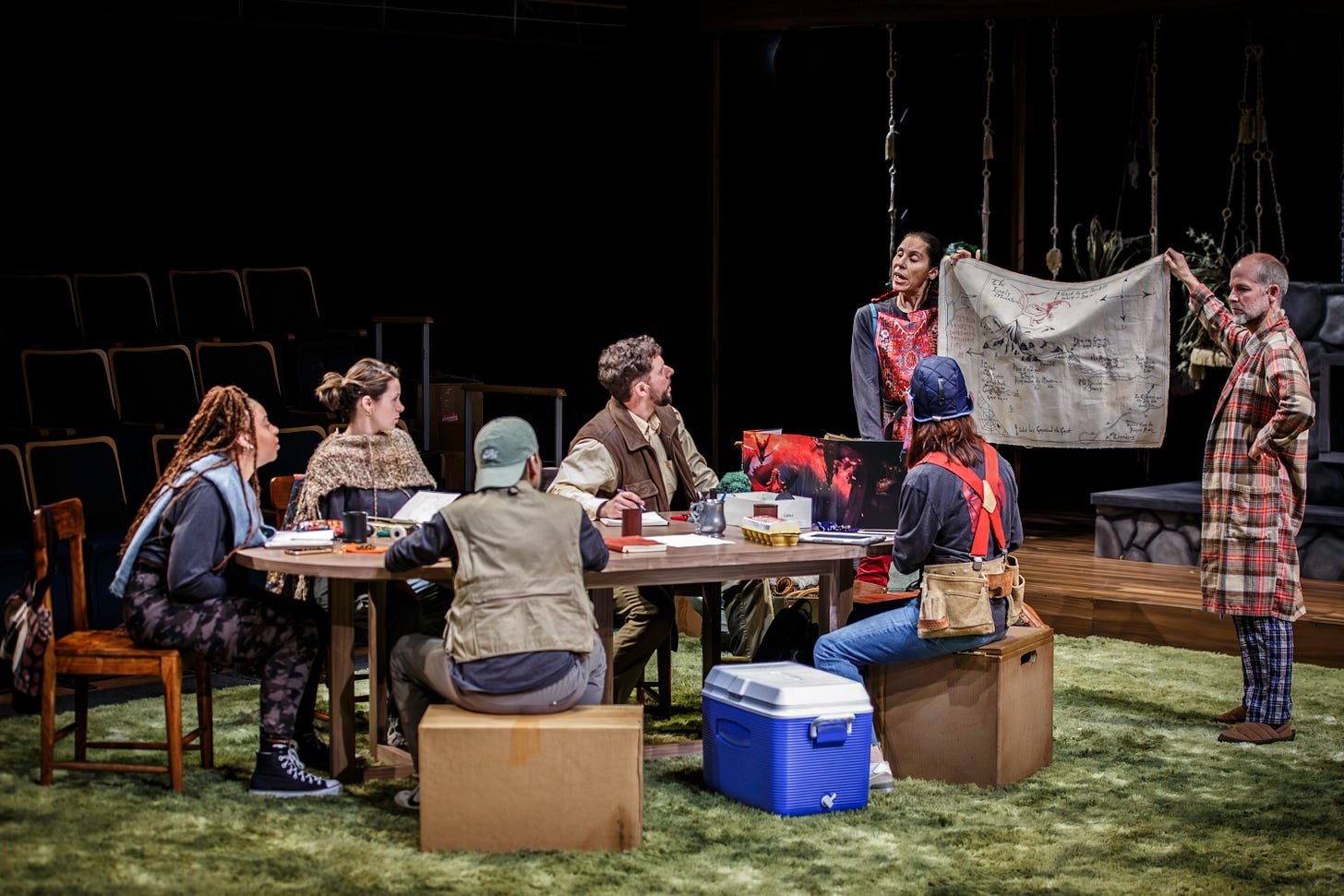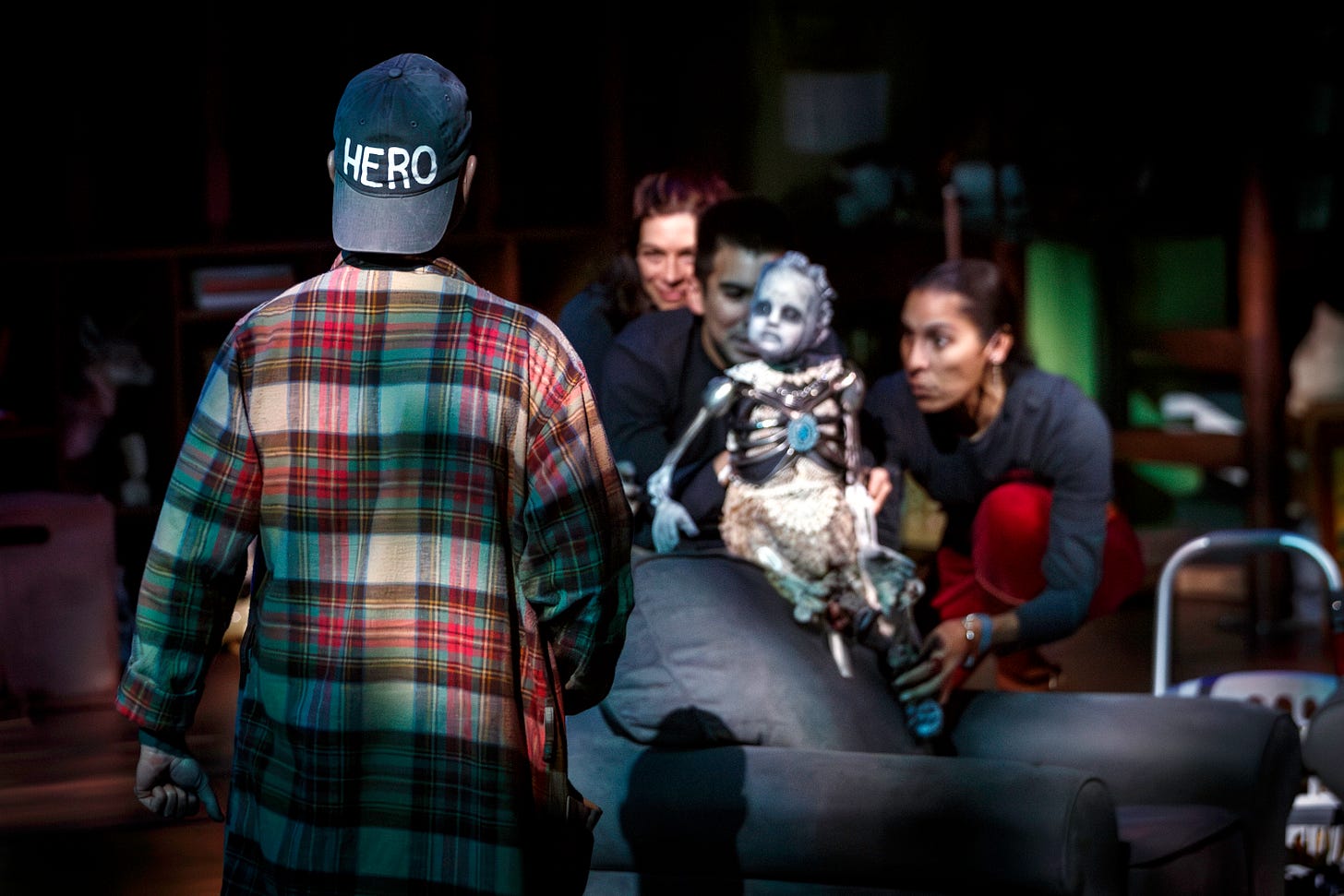Three views on THE HOBBIT at Pittsburgh Public Theater
Child’s Play - Elise Ryan
Enchantment—theatrical or otherwise—depends on transport. Songs, memories, objects, and people carry us away, if only in our minds, and give us the chance to journey away from ourselves in order to return to ourselves. J.R.R. Tolkien’s “The Hobbit” relies on just this sort of enchanted journey with a magic ring in a Middle Earth populated by trolls, dwarves, gigantic spiders, and a Hobbit who leaves all his comforts to adventure forth with friends.
We often associate these forms of enchantment with a child’s sense of magical possibility in the world. Greg Banks’s adaptation of The Hobbit has typically been staged as a children’s theater production with Bilbo Baggins played by a young actor. One strength of Pittsburgh Public Theater’s production of The Hobbit is its presentation of an adult world reenchanted through play. Director Marya Sea Kaminski’s production adds the frame narrative of a group of adult friends gathering to play Dungeons & Dragons. The adventures they encounter on their D&D campaign are the adventures that structure the narrative of Tolkien’s “The Hobbit”.
In this production Bilbo (Russell Saylor) isn’t content in his Hobbit home with good food and hot tea. This Bilbo is worn down by life and by grief. He’s retreated from the world, even as he longs to be invited back into community.
The most dazzling link between the child’s and the adult’s world is in PPT’s other innovation with the play: fantastical puppets co-designed by Jamie Agnello and Matt Acheson and performed by the same actors taking on the Dwarf roles. With every puppet—the larger-than-life Trolls, the stalking Wargs, the gigantic spider who could tickle her prey to death—I felt a sense of delight and wonder.
What does it say about me, though, that Gollum beguiled me the most?
The size of a large baby doll, the Gollum puppet is covered in metallic paint and wears a bejeweled breastplate, all of which sparkles in the low light, making the darkness onstage denser but also more attractive. In this production, Shammen McCune (Gandalf), José Pérez IV (Bombur), and Amy B. Marsalis (Balin) control the Gollum puppet and speak the same lines such that each word hits just behind the others. Gollum’s riddling mesmerizes. The puppet is always more than one thing, always divided. The choice to make the puppet’s shine also reflect upon its handlers only amplifies this sense of divided movement and motivation. Gollum is a fractured figure in the story, and the use of a puppet in this production isn’t solely illustrative of that divided self. Amazingly, the complex interaction between human and puppet showcases the material and bodily terror of a split self and brings something new to a character embedded in the cultural imagination.
And isn’t this the wonder of objects, especially objects on stage, that are lively and interactive, world-building and enchanting? With a childlike sense of possibility, this production of The Hobbit puts faith in things—puppets, game boards, even a travel mug—as portals to other identities and other worlds.
Of “Dungeons & Dragons” and a Shag-Carpeted Shire - Emma Diehl
To take on intellectual property so visually familiar to the viewing public is a tall order for any theater, and to make it appealing to all audiences is doubly challenging.
The Public’s staging of Greg Banks’s adaptation of “The Hobbit” is geared more towards children, and in many ways, nudging the audience towards child-like wonderment benefits the production.
From the opening moments, it’s clear the cast and direction have play in mind. Actors emerge from the audience to take their place on stage, and the production is framed through a “Dungeons & Dragons” game. Huddled around a table, the actors begin their journey with the roll of a die.
It’s that sense of play, coupled with the playful set design by Jennifer Zeyl, that clearly set expectations for the performance. The stage, covered in a wall-to-wall shag carpet that both evokes a 1970s basement and The Shire, giving the space a worn-in feel. This is not the CGI-laden, mo-cap adaptation you’ve seen on screen.

In their efforts, coupled with lighting, sound, and puppetry, we are transported. I found myself so carried away with the effects that I forgot the framing device, and in some ways, the limitations of live theater. We are in a living room, we are playing a game of D&D, and no dragon will appear out of thin air.
In these moments pulling the stage direction back to into the framing device, showing the actors gathered around the table again, rolling dice for initiative, or repositioning their characters on the map would’ve been a sweet but small reminder that within the performance, these are performers playacting “The Hobbit.”
Though the play is a technical delight, the actors should not be ignored. The cast, most of whom rarely leave the stage during the length of the show, sprint laps around the theater, appearing and reappearing as different characters. They operate puppets, they sword fight, they engage in light crowd work.
In this way, we are all asked to play, to imagine, and to join in the reluctant hobbit, Bilbo Baggins (Russell Saylor), in an unexpected adventure.
And it is, in many ways, unexpected. Even if you know the story, the production creates moments of delight across the 2 hour-plus performance. When goblins, wolves, and spiders, cleverly crafted from home objects, populate the stage, there were audible gasps. When a fantastically unsettling puppeteered Gollum appears, you could hear seats across the theater creaking as people repositioned to get the best view of the delicate yet impactful character.
There are also moments of sleight of hand, trap doors, and disappearances that created moments of awe. Though wrapped in a story familiar to many, “The Hobbit” is a refreshing take on the classic story.
They were right when they said live theater is magic - Lindsay Herring
The Hobbit, currently at the Pittsburgh Public Theater, is the ultimate form of make-believe.
Starting with a group of seven friends playing a tabletop “Dungeons & Dragons” style game, the show transformed into The Hobbit storyline so many folks are familiar with, filled with huge puppets, sword fighting, and even moments where characters broke into song. The play continually went back and forth, acknowledging the game within the storyline.
I was invested every moment. It felt like playing pretend when I was a child—and this show takes play very seriously. This gravity allowed me to become one with the make-believe, caused me to gasp aloud with the entry of each new fantastical creature—like the spider, made out of everyday items like plastic laundry baskets, tying the show back to its premise of a storytelling game in someone’s home.
Outside of my writing with Critical Insight, I work as a performer for a live nationally-touring theater group intended for both adults and children alike. I understand how difficult it is to capture the attention of an intergenerational audience when it comes to content and intention, but the actors did exactly that. As the show was ensemble based, almost all of the actors played multiple roles, or became puppets throughout. Their ability to capture such diverse characters, voices, was so much fun to watch.
While the actors were critical in the show’s success, the design elements made The Hobbit even more notable. I was in constant awe of the creative use of the incredible set design by Jennifer Zeyl. What began as an old home of ‘70s inspiration that had accumulated stuff over time became part of the make-believe. Every crevice was accounted for. Macrame knitted plant hangers became swings and stands on which the characters could “fly.” Boxes of junk, stacks of old magazines, and used records turned into gold. Hidden ladders and trapdoors emerged left and right. Immersive sound design (by Zach Moore) filled the O’Reilly Theater with ambient sounds to indicate scenery changes.
Set-wise, almost the whole theater was used as part of the show. And the characters really hit the mark on the ability to make us feel a part of the story, popping in and out of the audience seating, and even handing signs to the front row, including them in the adventure.
It’s clear that director Marya Sea Kaminski poured so much into this show. The night I went, the audience was filled with children, both young and old. There were audible reactions throughout the night, showing how invested we stayed throughout. To see that happen in a live setting was magical.




